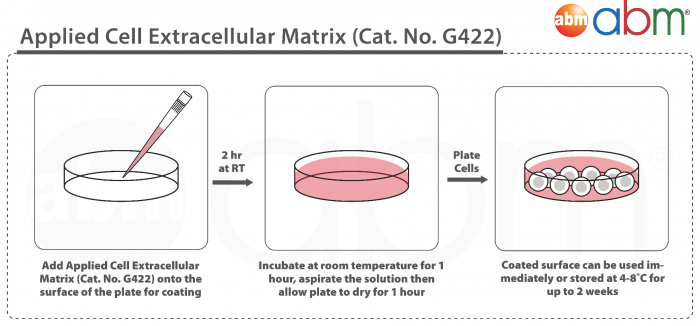
Applied Cell Extracellular Matrix 25ml

| CAT.NO | UNIT |
|---|---|
| G422 | 25ml |
| Description | In cell biology, processes such as cell differentiation, cell cycle and cell survival are affected by signals stimulated through cell adhesion. Therefore adhesion plays a fundamental role in in vitro studies. ABM’s Applied Cell Extracellular Matrix composes mainly of type I collagen, isolated from rat (Rattus rattus) tail tendon. Type I collagen is the most abundant form of collagen and differs from other collagens by its low lysine hydroxylation and low carbohydrate composition. This product is suitable for usage as a solid gel or for coating of culture wares. ABM’s Applied Cell Extracellular matrix on culture surfaces have been shown to enhance cell attachment in a wide variety of cell lines such as hepatocytes, fibroblasts and epithelial cells. |
|---|---|
| SKU | G422 |
| Unit quantity | 25ml |
Supporting Protocol
MSDS
QC
Other
How much of this solution (G422) would you recommend to use in 75cm2 and 175cm2 flasks?
The amount of solution should cover the entire surface of the culture ware. In the case of 75cm^2 and 175cm^2, we recommend using a minimum of 5ml and 10ml respectively.
How much should I use for a T75 flask?
For a T75 flask, we recommend using 5ml - 7ml of our Applied Cell Extracellular Matrix (G422).
How much should I use to coat a T25 flask?
We suggest using 0.5 - 1ml to coat a T25 flask
Can I use fibronectin coated flasks instead of collagen for primary cells from brain?
You may use fibronectin coated flasks, however we cannot guarantee the cells will meet their maximum proliferation rate when doing so. The information specified for passage number and proliferation rate has been based on culturing these cells in ECM coated plates or flasks (Cat.No.G422)
How long should I left the ECM for before plating cells? Should I wash flasks with PBS before plating cells?
We advise leaving the wells or dishes for ~1 hour to allow the coated surface to dry completely. Coated plasticware can then be used immediately without needing to wash with PBS. Alternatively, the coated flasks can be 4 - 8ºC for up to 2 weeks.
Should this product be used on tissue-culture treated plates/flasks or untreated?
It can be used on both.
How much G422 do you recommend to coat a T175 flask?
We recommend using 20mL of G422 to coat a T175 flask. You may top up the volume using 1X sterile PBS to keep collagen moist while coating. This can be done by diluting G422 (1:1) with PBS and follow the rest of the protocol as per our website.
I am having an issue with the solution coming off of my flask in loose clumps. Is there any way to prevent this when plating?
This can occur if the ECM is used in excess or if it is not coated evenly. We suggest diluting the ECM with media (1:1) and leaving it for a longer time to produce a more homogeneous layer.
How can I prevent the ECM from coating too thickly, and very unevenly?
We have had success in creating a thin coating by diluting the G422 with PBS before coating. Additionally, it has been found that shorter incubation time and dilution with media has also helped.
How much G422 should I used to coat a dish that is 100mm x 20mm?
For a dish that is 100mm x 20mm (i.e. with a surface area that is roughly ~55 cm^2), we would recommend ~1.5-2 mL of matrix to cover the surface. However, your are certainly able to add a bit more of the matrix if you are looking for a thick coating for your application.
Does G422 have any lipid or lipid derivatives?
G422 may have some lipid traces or related materials since it is complex heterogeneous mixture of extracellular matrix.
- Chesnokova, V. et al. "Growth hormone is a cellular senescence target in pituitary and nonpituitary cells" Proc Natl Acad Sci U S A 35:E3331-E3339 (2013). DOI: 10.1073/pnas.1310589110. PubMed: 23940366. Application: Cell Culture.
- Chesnokova, V; et al. "Growth hormone is a cellular senescence target in pituitary and nonpituitary cells" Proceedings of the National Academy of Sciences 35:E3331-E3339 (2013). PubMed: 23940366. Application: Cell culture.
- Sakaguchi, M et al. "miR-137 Regulates the Tumorigenicity of Colon Cancer Stem Cells through the Inhibition of DCLK1."" Molecular Cancer Research 14.4:354-362 (2016). DOI: 10.1158/1541-7786.MCR-15-0380. Application: Treat precultured plates.
- Robitaille, K et al. "High-throughput Functional Genomics Identifies Regulators of Primary Human Beta Cell Proliferation" Journal of Biological Chemistry 291.9:4614-4625 (2016). DOI: doi: 10.1074/jbc.M115.683912 . Application: Treat precultured plates.
- Chesnokova, V et al. "Growth hormone is permissive for neoplastic colon growth" Proceedings of the National Academy of Sciences of the United States of America 113.23:E3250–E3259 (2016). DOI: 10.1073/pnas.1600561113. Application: Cell culture.


